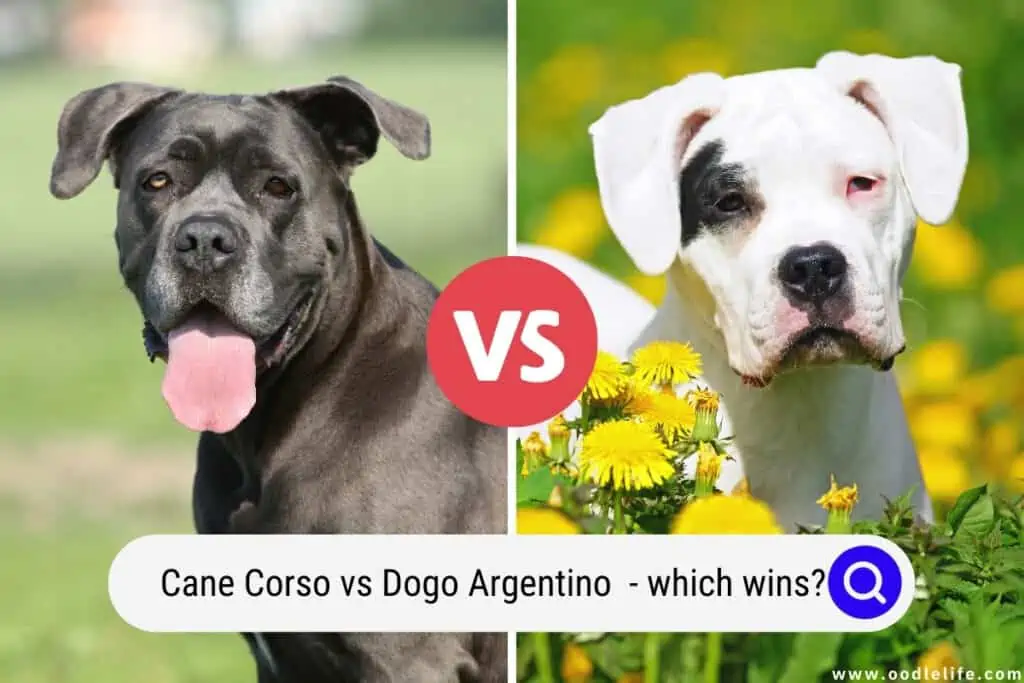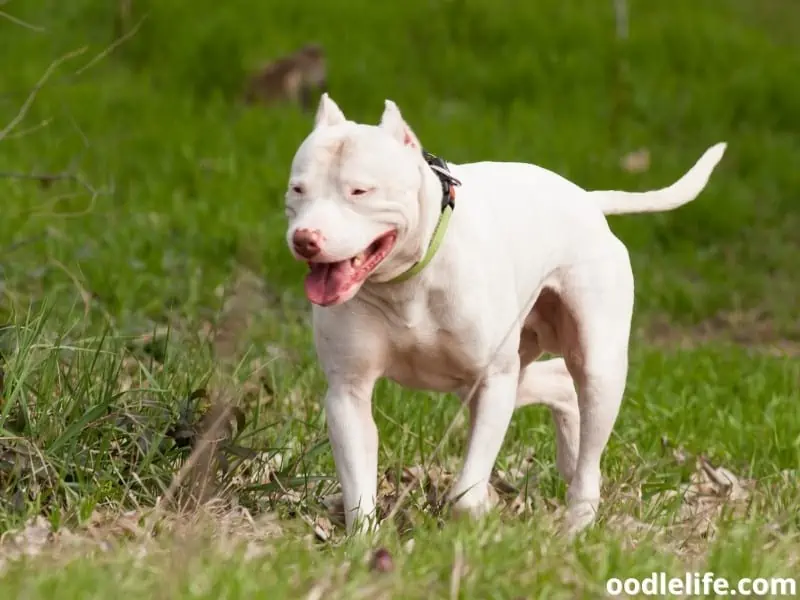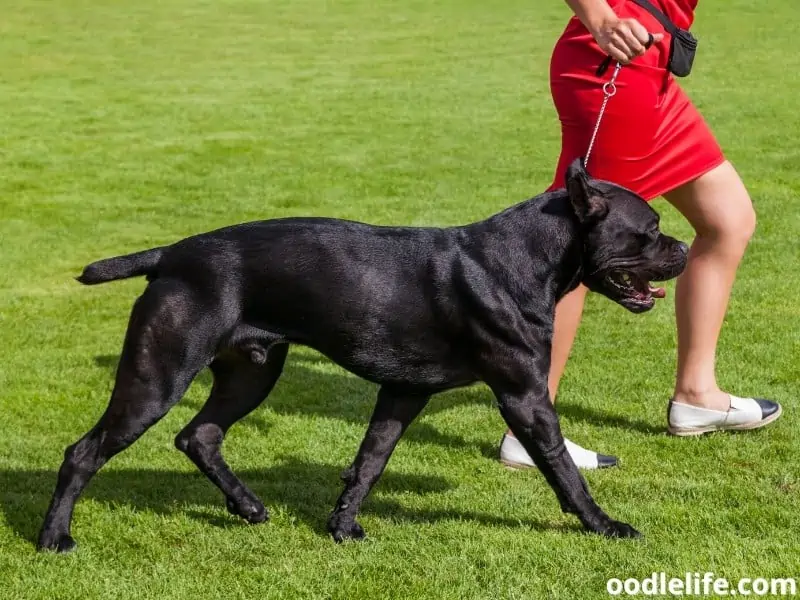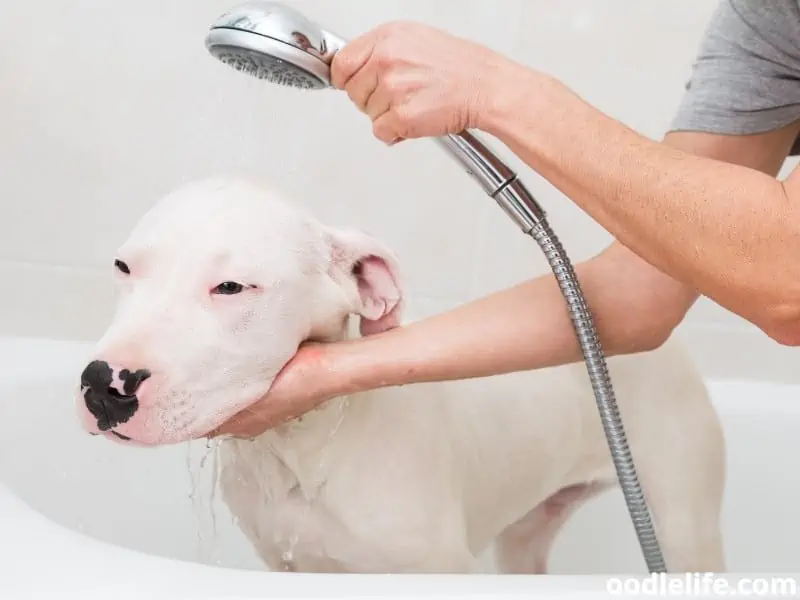Cane Corso vs Dogo Argentino (Which Wins?) and Photos
You may have come here because you’re interested in comparing the Cane Corso vs Dogo Argentino for their strength. Or, you might want to know if these breeds make loyal companion dogs.
Regardless of your reasoning, I’ll give you a well-rounded perspective of these breeds so that you can understand why these dogs have a rough-around-the-edges reputation, their care requirements, and the ideal kind of households for them.

Breed History
Both the Cane Corso and Dogo Argentino descend from Mastiff dogs. However, they originated in entirely different parts of the world.
Cane Corso
The Cane Corso is from ancient Italy, and the dogs were valuable to soldiers fighting for their territory. As such, the Cane Corso inherited fearlessness and were helpful as guard dogs.
Cane Corsos were also invaluable to farmers back in the day, as they chased wild boar, hauled carts, and protected livestock. They were also excellent companions to hunters.
The Cane Corso nearly became extinct between the 19th and early 20th centuries. While no one knows why this was, historians believe it could be due to the shift in farming practices.
In the 1970s, a group of men who remembered their childhoods with Cane Corsos worked to bring back the breed along with some other Italian Cane Corso activists. In 1988, this breed arrived in the United States, and the American Kennel Club (AKC) recognized it as an official breed in 2010.

Dogo Argentino
The Dogo Argentino is from Cordoba, Argentina. Dr. Antonio Nores Martinez crossbred the Old Fighting Dog of Cordoba with several dog breeds to arrive at the Dogo Argentino. Some of the breeds included a mix of sweet and feisty like the Great Dane, Bull Terrier, and Boxer.
The result was a strong and sturdy dog that became recognized in Argentina in 1964. In fact, it was the only genuinely Argentinian breed that they recognized.
Nowadays, the Dogo Argentino is a beloved dog that you can find in many parts of the world. It shares many qualities with Cane Corsos, including being intelligent and an excellent guard dog.
The AKC recognized Dogo Argentinos as an official breed in 2020, a decade after Cane Corsos.

The Defining Characteristic: Coat Color
It can be hard to tell the difference between Cane Corsos and Dogo Argentinos to the untrained eye. However, one tell-tale sign can distinguish the two: their coloring.
The Dogo Argentino’s coat comes in pure white. That’s it—they usually have any markings or any other colors that mix in with their white base, except for a dark patch by their eye in some cases.
In contrast, the AKC recognizes the following seven colors in Cane Corsos:
- Black
- Fawn
- Gray
- Gray Brindle
- Red
- Black Brindle
- Chestnut Brindle
If you think I forgot to include white on this list, you’re mistaken. There’s no such thing as a white Cane Corso. So, if you know you’re looking at either a Dogo Argentino or Cane Corso but can’t pinpoint the exact breed, the color is an infallible indicator.

Other Characteristics
Both the Cane Corso and Dogo Argentino are large, muscular dogs. And while that can make them appear similar, they have several other characteristics aside from color that differentiates them.
Let’s start with their size, which you can view in the chart below comparing the Cane Corso vs Dogo Argentino
| Breed | Height | Weight |
| Cane Corso | 23.5 to 27.5 inches | 88 to 110 pounds |
| Dogo Argentino | 24 to 26.6 inches | 80 to 100 pounds |
In both cases, females are often on the shorter and lighter end of these size ranges.
While both dogs are muscular, Cane Corsos look even bulkier than Dogo Argentinos. They have a short, thick coat that’s smooth to the touch. These dogs have massive heads and, because of their size and body makeup, tend to have a relatively more intimidating appearance than Dogo Argentinos.
In contrast, Dogo Argentinos also have a large head, but it sits on a slightly more elegant-looking neck. Such elegance matches the rest of their body, which also has a relatively more slender and refined appearance. Like Cane Corsos, Dogo Argentinos have smooth, short fur.

Personalities
Some of the most common personality traits Cane Corsos have include being loyal, willful, eager to please, and assertive. On the other hand, Dogo Argentinos are intelligent, protective, affectionate, and friendly.
Since both of these dogs become cautious around strangers, it’s crucial to introduce them to other people and dogs at a young age. That way, they can grow up learning that strangers are friends who will treat them well.
While both Cane Corsos and Dogo Argentinos are loyal and loving to their family clan, you should always monitor young children around them. That’s especially the case if you adopt your pet and don’t know their history.

Exercise Requirements
A Cane Corso or Dogo Argentino that’s bored and has pent-up energy is never a good thing. So, when deciding between the two breeds, know that both dogs require extensive exercise to stay happy and healthy.
You should aim to give your Cane Corso and Dogo Argentino a minimum of two hours of exercise per day, split up into at least two different sessions.
If that sounds like a lot, then neither of these breeds is likely for you. Furthermore, putting your dog outside and calling it good exercise isn’t enough.
These dogs love to go on hikes, do agility courses, go for a run, and do any other high-intensity activity with their owners.
Generally speaking, keeping either dog on a leash while exercising with them in public is best. Of course, you’ll ultimately know your pet best. But since their genetic wiring is to react when they become startled or are around strangers, it’s best to start by playing it on the safe side.

Trainability
Cane Corsos and Dogo Argentinos have high intelligence. And because of that, they rely on a confident owner who can challenge them by varying their training and remain consistent with their cues.
Using positive reinforcement techniques is crucial when training Dogo Argentinos and Cane Corsos. Yelling at your dog will not only make them fearful of you, but it could cause them to lash out.
Of the two breeds, Cane Corsos are typically easier to train because they can be a bit more reserved. Nevertheless, either dog will gladly show dominant behaviors around your home unless you get them into a training program early.

Grooming Needs
Of the two breeds, Cane Corsos shed less than Dogo Argentinos. Nevertheless, because they have such short hair, they both have low grooming needs.
Dogo Argentinos and Cane Corsos to shed heavier in the spring and fall as they prepare for the change of seasons. You’ll find extra hair on your floor these times of the year, although you’ll need to run the vacuum to scoop up hair regardless of the month.
I recommend brushing your Cane Corso or Dogo Argentino with a soft brush at least once per week, although Dogo Argentinos will benefit from more frequent brushings.

Comparing Strength (Biting Strength)
Based on their appearance, no one can deny that the Cane Corso and Dogo Argentino are strong. But of the two, Cane Corsos win for being the strongest.
Cane Corsos have about 700 pounds per square inch (PSI) bite force. In contrast, Dogo Argentinos “only” have a bite force of around 500 PSI.
Both of these PSIs are close to the lion, which can range from 650-1000 PSI bite force. In contrast, humans have a bite force of 150 PSI, and crocodiles a 3,700 PSI.
Ouch!
Running speeds are another factor to consider when comparing the Cane Corso vs Dogo Argentino. And yet again, the Cane Corso takes the cake for this.
Whereas Dogo Argentinos average a 25-mile-per-hour running speed, Cane Corsos can run up to 32 miles per hour.

Health Issues
The minimum lifespan for both the Cane Corso and Dogo Argentino is nine years. That’s typical for many larger dog breeds, which tend to die younger than smaller dogs. However, Dogo Argentinos average a longer lifespan of up to 15 years compared to the Cane Corso’s 12 years.
Cane Corso
Below are some of the most common health issues that Cane Corsos encounter:
- Hip dysplasia
- Idiopathic epilepsy
- Eyelid abnormalities
- Gastric dilation volvulus

Dogo Argentino
Some of the most common ailments that Dogo Argentinos face include:
- Deafness
- Hip dysplasia
- Hypothyroidism
- Autoimmune thyroiditis
You likely noticed that hip dysplasia is on these lists for both Cane Corsos and Dogo Argentinos. Such a condition is common in large dogs, as it’s hereditary and happens when these dogs are growing.
So, you’ll know whether your Dogo Argentino or Cane Corso has hip dysplasia before they become an adult.
Hip dysplasia can cause numerous issues for dogs as they age, including arthritis, reduced mobility, and muscle atrophy. In some situations, your veterinarian might recommend surgery to treat the problem. Doing so will decrease the chances of your dog developing arthritis later in life.

Cane Corso vs Dogo Argentino: The Winner
Choosing a “winner” between the Cane Corso and Dogo Argentino depends partly on the category you’re analyzing and partly on personal preference.
The Cane Corso is hands-down the winner regarding bite force and running abilities. And yet both of these dogs are winners for making excellent guard dogs and being loyal to their owners.
If you have young children and are considering bringing home a Cane Corso or Dogo Argentino, I encourage you to look elsewhere. While these dogs can be good around children, their breeding makes it so they can react harsher than certain other breeds.
In either case, the Cane Corso and Dogo Argentino are steadfast and loving breeds for the right owner.